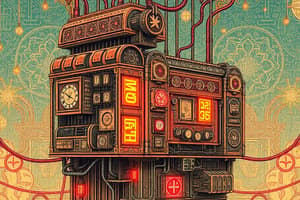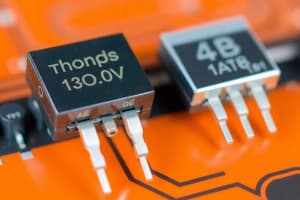Podcast
Questions and Answers
What is the basic function of flip-flops and latches in digital electronics systems?
What is the basic function of flip-flops and latches in digital electronics systems?
- Generate and transmit signals
- Serve as storage elements for sequential logic (correct)
- Act as primary processing units
- Control the power supply to the system
What are flip-flops and latches in electronics?
What are flip-flops and latches in electronics?
- Circuits with variable states for processing information
- Circuits with single stable states for transmitting information
- Circuits with two stable states for storing information (correct)
- Circuits with multiple stable states for amplifying information
How does a flip-flop or latch change state?
How does a flip-flop or latch change state?
- By automatic internal programming
- By signals applied to the output
- By signals applied to one or more control inputs (correct)
- By adjusting the power supply
What does the output of a flip-flop or latch depend on in a finite-state machine?
What does the output of a flip-flop or latch depend on in a finite-state machine?
What type of data does a flip-flop or latch store?
What type of data does a flip-flop or latch store?
What is the basic function of flip-flops and latches in digital electronics systems?
What is the basic function of flip-flops and latches in digital electronics systems?
What type of data does a flip-flop or latch store?
What type of data does a flip-flop or latch store?
What is the relationship between the output and next state in a finite-state machine using flip-flops or latches?
What is the relationship between the output and next state in a finite-state machine using flip-flops or latches?
What is the primary function of flip-flops and latches in electronics systems used in computers and communications?
What is the primary function of flip-flops and latches in electronics systems used in computers and communications?
What is the role of flip-flops and latches in a sequential logic circuit?
What is the role of flip-flops and latches in a sequential logic circuit?
Flashcards
Flip-Flops and Latches
Flip-Flops and Latches
Storage elements in sequential logic that hold state information.
What are Flip-Flops/Latches?
What are Flip-Flops/Latches?
Circuits with two stable states, used for storing one bit of information.
How Flip-Flops Change State
How Flip-Flops Change State
Through signals applied to its control inputs, triggering a transition between its stable states.
Data Stored
Data Stored
Signup and view all the flashcards
Primary Function
Primary Function
Signup and view all the flashcards
Role in Sequential Logic
Role in Sequential Logic
Signup and view all the flashcards
Output Dependency
Output Dependency
Signup and view all the flashcards
Study Notes
Flip-Flops and Latches in Digital Electronics
- Flip-flops and latches are fundamental components in digital electronics systems, used to store and manipulate binary data.
- The primary function of flip-flops and latches is to act as memory elements, storing 1-bit binary data.
- Flip-flops and latches change state based on input signals, clock signals, and/or reset signals.
- The output of a flip-flop or latch in a finite-state machine depends on the current state and the input signals.
- Flip-flops and latches store binary data, which can be either 0 or 1.
- The relationship between the output and next state in a finite-state machine using flip-flops or latches is that the output determines the next state.
- In electronics systems used in computers and communications, the primary function of flip-flops and latches is to provide memory and sequential logic capabilities.
- In a sequential logic circuit, flip-flops and latches play a crucial role in storing and transferring data between different stages of the circuit.
Studying That Suits You
Use AI to generate personalized quizzes and flashcards to suit your learning preferences.




